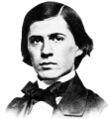Template:Selected anniversaries/April 19: Difference between revisions
No edit summary |
No edit summary |
||
| Line 1: | Line 1: | ||
<gallery> | <gallery> | ||
||Gustav Theodor Fechner (b. 19 April 1801), was a German philosopher, physicist and experimental psychologist. An early pioneer in experimental psychology and founder of psychophysics, he inspired many 20th century scientists and philosophers. He is also credited with demonstrating the non-linear relationship between psychological sensation and the physical intensity of a stimulus | ||Gustav Theodor Fechner (b. 19 April 1801), was a German philosopher, physicist and experimental psychologist. An early pioneer in experimental psychology and founder of psychophysics, he inspired many 20th century scientists and philosophers. He is also credited with demonstrating the non-linear relationship between psychological sensation and the physical intensity of a stimulus which became known as the Weber–Fechner law. Pic. | ||
||1806 – Isambard Kingdom Brunel, English engineer, designed the Clifton Suspension Bridge (d. 1859) | ||1806 – Isambard Kingdom Brunel, English engineer, designed the Clifton Suspension Bridge (d. 1859) | ||
Revision as of 21:15, 18 April 2018
1881: Mathematician Karl Mikhailovich Peterson dies. He discovered equations which subsequently named the Gauss–Codazzi equations, fundamental to the theory of embedded hypersurfaces in a Euclidean space.
1882: Large herd of Flying bison (Bison pterobonasus) migrates from Periphery to New Minneapolis, Canada.
1912: Chemist Glenn T. Seaborg born. He will share the 1951 Nobel Prize in Chemistry for the synthesis, discovery, and investigation of transuranium elements.
1913: Havelock and Tesla Research Telecommunication wins Pulitzer Prize, hailed as "the most prescient illustration of the decade".
1914: Mathematician and philosopher Charles Sanders Peirce dies. He is remembered as "the father of pragmatism".
2016: Theoretical physicist, theoretical chemist, and Nobel laureate Walter Kohn dies. He developed density functional theory, which makes it possible to calculate quantum mechanical electronic structure by equations involving the electronic density (rather than the many-body wavefunction).
2017: Steganographic analysis of Shell unexpectedly reveals "at least four-thousand and ninety six kilobytes" of encrypted data.






